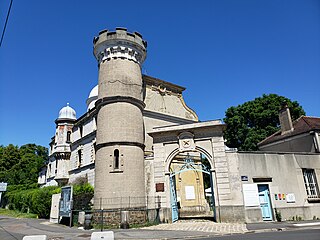Copernicus may refer to the astronomer Nicolaus Copernicus (1473-1543).

Eugène Michel Antoniadi was a Greek-French astronomer.
Bernard Ferdinand Lyot was a French astronomer.

Nicolas Camille Flammarion FRAS was a French astronomer and author. He was a prolific author of more than fifty titles, including popular science works about astronomy, several notable early science fiction novels, and works on psychical research and related topics. He also published the magazine L'Astronomie, starting in 1882. He maintained a private observatory at Juvisy-sur-Orge, France.

Kasimir Romuald Graff was a Polish-German astronomer. He worked as an assistant at the Hamburg Observatory and became a professor at Hamburg in 1916. In 1928 he became director of the Vienna Observatory, Austria. When the Nazi government took over in Austria in 1938, he was forced to retire. It is likely that his family background and his rejection of the Nazi-supported philosophy of "Welteislehre" was the reason, although he officially was removed because of unproven charges of embezzlement. He was reinstated in 1945, and he retired in 1949.

Carl Ernst Albrecht Hartwig was a German astronomer.
Yevgeny Yakovlevich Perepyolkin was a Soviet astronomer. He headed the astrophysics department of the Pulkovo Observatory until he was arrested on 11 May 1937 for counter-revolutionary agitation. He was sent to a penal labour camp in Krasnoyarsk Krai, and was executed on 13 January 1938.

Flammarion is a lunar impact crater on the south edge of Sinus Medii. Its diameter is 76 km. It is named after the French astronomer Camille Flammarion. It is located between the crater Mösting to the northwest and Herschel to the southeast. The bowl-shaped Mösting A intersects the western rim of Flammarion.
There are several impact craters named Herschel in the Solar System, although the best known is the huge crater on Saturn's moon Mimas. Most are named after the eighteenth-century astronomer William Herschel.
Gabrielle Renaudot Flammarion was a French astronomer. She worked at the Camille Flammarion Observatory at Juvisy-sur-Orge, France, and was General Secretary of the Société Astronomique de France.
The classical albedo features of Mars are the light and dark features that can be seen on the planet Mars through an Earth-based telescope. Before the age of space probes, several astronomers created maps of Mars on which they gave names to the features they could see. The most popular system of nomenclature was devised by Giovanni Schiaparelli, who used names from classical antiquity. Today, the improved understanding of Mars enabled by space probes has rendered many of the classical names obsolete for the purposes of cartography; however, some of the old names are still used to describe geographical features on the planet.
Casimir Marie Gaudibert was a French amateur astronomer and selenographer.

1021 Flammario, provisional designation 1924 RG, is a dark background asteroid from the central regions of the asteroid belt, approximately 100 kilometers in diameter. It was discovered on 11 March 1924, by German astronomer Max Wolf at the Heidelberg-Königstuhl State Observatory in Heidelberg, Germany. The asteroid was named after French astronomer Camille Flammarion. The uncommon F-type asteroid has a rotation period of 12.16 hours.

The Société astronomique de France, the French astronomical society, is a non-profit association in the public interest organized under French law. Founded by astronomer Camille Flammarion in 1887, its purpose is to promote the development and practice of astronomy.
Kuiper is a Dutch surname.

Flammarion is an impact crater in the Syrtis Major quadrangle on Mars at 25.2 ° N and 48.3 ° E. It is 173.0 km in diameter. Its name was approved in 1973, and refers to French astronomer Camille Flammarion. There may have been a lake in the crater in the past because a channel is present on the northern rim, and sedimentary layers are present within the crater.

The observatory was established in Juvisy-sur-Orge in 1883 by the French astronomer and author Camille Flammarion. In March 2010, the structure was classified as a historical monument by the French Ministry of Culture. The observatory belongs to the Société astronomique de France.
This page is based on this
Wikipedia article Text is available under the
CC BY-SA 4.0 license; additional terms may apply.
Images, videos and audio are available under their respective licenses.








